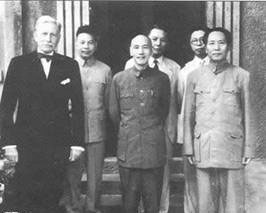Difference between revisions of "Double Ten Agreement"
imported>Ciic |
imported>Ciic |
||
| Line 1: | Line 1: | ||
[[File:Double ten agreement.jpg|thumb|300px|Leaders of the CPC and Kuomintang (From the right: Mao Zedong, Wang Shijie, Zhang Qun, Chiang Kai-shek, Chiang Ching-kuo, and Patrick Jay Hurley, US ambassador to China)]] | [[File:Double ten agreement.jpg|thumb|300px|Leaders of the CPC and Kuomintang (From the right: Mao Zedong, Wang Shijie, Zhang Qun, Chiang Kai-shek, Chiang Ching-kuo, and Patrick Jay Hurley, US ambassador to China)]] | ||
| − | On October 10, 1945, the "'''Double Ten Agreement'''," formally known as the "Summary of Conversations" between Kuomintang representatives | + | On October 10, 1945, the "'''Double Ten Agreement'''," formally known as the "Summary of Conversations" between Kuomintang representatives Wang Shijie, Zhang Zhizhong and Shao Lizi and Communist Party representatives [[Zhou Enlai]] and Wang Ruofei, was signed in [[Chongqing]]. |
The agreement included twelve articles: 1) Basic principles on constructing a new China by peaceful methods; 2) Political democratization; 3) Starting a new Congress or Assembly; 4) Freedom of the people; 5) Legalization of political parties; 6) Problems of Secret Service; 7) Problems of releasing political prisoners; 8) Local self-government; 9) Re-planning and management of the post-war Chinese armed forces; 10) Issues on the local government in liberated areas; 11) Issue on traitors and puppet governments; and 12) Issue of surrender. | The agreement included twelve articles: 1) Basic principles on constructing a new China by peaceful methods; 2) Political democratization; 3) Starting a new Congress or Assembly; 4) Freedom of the people; 5) Legalization of political parties; 6) Problems of Secret Service; 7) Problems of releasing political prisoners; 8) Local self-government; 9) Re-planning and management of the post-war Chinese armed forces; 10) Issues on the local government in liberated areas; 11) Issue on traitors and puppet governments; and 12) Issue of surrender. | ||
Revision as of 02:25, 10 October 2014
On October 10, 1945, the "Double Ten Agreement," formally known as the "Summary of Conversations" between Kuomintang representatives Wang Shijie, Zhang Zhizhong and Shao Lizi and Communist Party representatives Zhou Enlai and Wang Ruofei, was signed in Chongqing.
The agreement included twelve articles: 1) Basic principles on constructing a new China by peaceful methods; 2) Political democratization; 3) Starting a new Congress or Assembly; 4) Freedom of the people; 5) Legalization of political parties; 6) Problems of Secret Service; 7) Problems of releasing political prisoners; 8) Local self-government; 9) Re-planning and management of the post-war Chinese armed forces; 10) Issues on the local government in liberated areas; 11) Issue on traitors and puppet governments; and 12) Issue of surrender.
The Kuomintang agreed to the basic principles on constructing a new China by peaceful methods, admitted the equal legal status of different parties and some certain democratic rights of the people, and promised to hold a "Political Discussion Conference," but refused to admit the Chinese Communist Party's regime and armed forces in the liberated areas.
